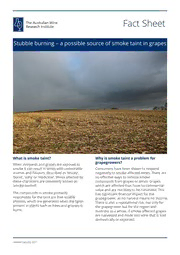
stubble burning fact sheet PDF
Preview stubble burning fact sheet
Fact Sheet Stubble burning – a possible source of smoke taint in grapes Please find attached signed T&C form. If there is anything else that we can What is smoke taint? Why is smoke taint a problem for to sign or you grapegrowers? When vineyards and grapes are exposed to smoke it can result in wines with undesirable Consumers have been shown to respond aromas and flavours, described as ‘smoky’, negnatievelye tod sm okbe-aeffefctoed wrinees . Tthheree are ‘burnt’, ‘ashy’ or ‘medicinal’. Wines affected by no effective ways to remove smoke these characters are commonly known as compounds from grapes or wines. Grapes 24/12, please let ‘smoke-tainted’. which are affected thus have no commercial value and are not likely to be harvested. This The compounds in smoke primarily has significant financial impact for the responsible for the taint are free volatile me know. grapegrower, as no harvest means no income. phenols, which are generated when the lignin There is also a reputational risk, not only for present in plants such as trees and grasses is the grapegrower but for the region and burnt. Australia as a whole, if smoke-affected grapes are harvested and made into wine that is sold domestically or exported. Updated January 2021 Fact Sheet When are grapevines susceptible to What is the risk of stubble burning smoke? affecting grapes? The effects of smoke vary depending on the Given grapes are susceptible to smoke when stage of grapevine development when smoke stubble burning typically occurs, there is a risk exposure occurs. In the past it was believed that grapes could become tainted from that early-season smoke exposure posed a exposure to smoke from stubble burning. The lower risk than exposure close to harvest; degree of risk will depend on many factors, however, data from Australian smoke events such as the amount of stubble/ha, the in 2019/20 showed that there is a significant temperature of the burn, wind speed and risk of perceptible smoke characters in wine, direction and other environmental conditions, even when smoke exposure occurs early in smoke density, the concentration of the grape berry development. The high-risk volatile phenol compounds, duration of period therefore typically extends from exposure and proPximleity oaf tshe evin eyfairdn. Wdhile November/December until April/May, the risk is likely to be less than that associated depending on the region, variety and seasonal with a bushfire, because stubble fires are less conditions. likealy tto rteasultc inh lonegerd-ter ms simgokne exepodsure , there is still a risk. Can burning stubble generate the compounds that cause smoke taint? How can theT ris&ks Cof s mfooker tamint f.r oImf stubble burns be reduced? Given that wheat, rice, rye, flax, corn, rice, oats and barley straws can contain between 6 Burning stubble near vineyards represents a there is anything and 34% lignin, the burning of stubble from risk of smoke taint if fruit is still present on such cereal crops would be expected to vines. If possible, it is therefore preferable to generate volatile phenols capable of tainting postpone any stubble burning until after else that we can grapes. Indeed, early smoke taint research grapes have been harvested. Communication showed that grapes could produce smoke- between district councils, cereal farmers and tainted wines following exposure to smoke grapegrowers about the timing of harvest and to sign or you generated by burning barley straw. the timing of proposed stubble burns will be important in avoiding risks of smoke taint Why are grapegrowers concerned from stubble burns. need before the about stubble burn? Acknowledgement Based on a survey of farmers in southern NSW, the months in which the burning of Th2is w4ork/ w1as2 sup,p oprtelde by aAusstraelia 'sl et stubble was most likely to be conducted were grapegrowers and winemakers through their March, April and May. Grapegrowers who investment body Wine Australia, with have varieties that might be harvested late in matching funds fromm the eAus tkralinan ow. the season may still have grapes on the vines Government. The AWRI is a member of the until well into May, which overlaps with the Wine Innovation Cluster in Adelaide. time that grain farmers might want to burn stubble. As such, growers are concerned that stubble burning may occur before the grape harvest, potentially causing taints. Updated January 2021 Fact Sheet Contact For further information, please contact the AWRI helpdesk team. Phone 08 8313 6600 Fax 08 8313 6601 Email [email protected] Website https://www.awri.com.au/industry_support/wi nemaking_resources/smoke-taint/ Address Wine Innovation Central Building, Corner of Hartley Grove & Paratoo Rd, Urrbrae (Adelaide), SA 5064 Please find attached signed T&C form. If there is anything else that we can to sign or you need before the 24/12, please let me know. Updated January 2021
